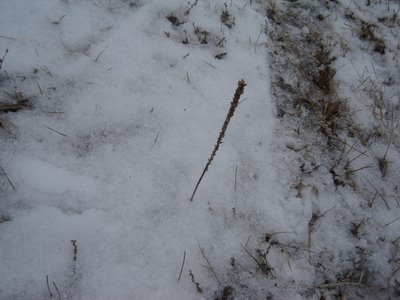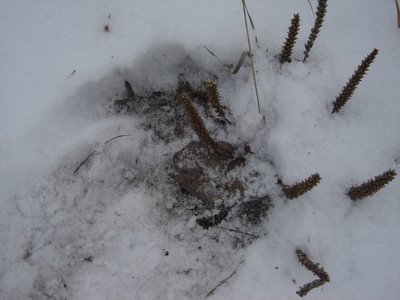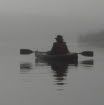Not so fast . . .
A couple of you commented on the common plantain, saying you were glad to be introduced to a familiar neighbour. I immediately started back-pedalling in my mind, wondering how many different plants might look superficially similar. To paraphrase a Bertrand Russell quote that Madcap posted yesterday: The trouble with getting to know plants is that beginners are recklessly confident, and more experienced people are tediously cautious.
I hope I don't get too tedious here.
It just happens that, on my quick walk with the camera yesterday, one of the other plants I spotted was Triglochin maritima, or seaside arrowgrass.

Mind you, I should confess that the specimen I spotted yesterday was more distinctive than this one.
It also happens that as I was walking home last night with the groceries, I kicked away the snow at the base of what appeared to be a plantain spike, and didn't find any leaf remains at all. Full of doubts, I went back out today and found the plant I had labelled "common plantain" in yesterday's post. Sure enough, under the snow, I found what I had expected to find.
 Large, broad, oval-shaped leaves (or what was left of them). All the leaves and spikes arise from one central point (the crown). You can see part of the outline of one leaf just below the centre of the photo. Its point of attachment is hidden in the snow to the right.
Large, broad, oval-shaped leaves (or what was left of them). All the leaves and spikes arise from one central point (the crown). You can see part of the outline of one leaf just below the centre of the photo. Its point of attachment is hidden in the snow to the right.I also got a bunch more photos of the seaside arrowgrass. I'm not happy with the focus and resolution of these, but together I hope they give you some sense of the plant. It's hard to be patient with the camera when it's below freezing, and breezy. Mind you, for January in these parts, I can't complain!

This long slender cluster of seeds is called a raceme. In this case, it's a spike-like raceme. It differs from the spike (which we saw in common plantain) by having the seeds on little stalks, instead of attached directly to the main stalk. In the right-hand image above, showing racemes with most of the seeds gone, you can see the little stalks that supported the seeds.
Here is the seaside arrowgrass plant that I spotted yesterday:

(It's the straw-coloured raceme front and centre.) If you saw a tall specimen like this, you probably wouldn't mistake it for common plantain. (Note to self - include a familiar object in photos for scale.) The base of the plant (just left of centre in the image below) is very different from common plantain.

Instead of large flat leaves, seaside arrowgrass has long slender grass-like leaves. (There are three clearly visible, all extending almost horizontally to the right.) In fact, this plant is much more closely related to grasses than it is to plantain. BUT - before you get thinking that this is simple, there are some other plantain species that have linear leaves!
Why bother learning all this? Well, a chewed leaf of common plantain makes a nice poultice for itchy insect bites. Seaside arrowgrass is poisonous to livestock (although there's rarely very much of it, and in a healthy pasture, livestock will probably avoid it).
Also, the more you learn, the easier the learning gets.
The more you learn about the ways plants are related, the easier it is to learn new plants, because you will have more hooks to hang your knowledge on. I was startled to notice the superficial similarity between common plantain and seaside arrowgrass (at least in winter, with the leaves hidden), because they come from very different groups of plants. Plantain is a dicot, and arrowgrass is a monocot. And now that I've found the definitions in Wikipedia, I see that I have some catching up to do on the latest details of plant classification. Nevertheless, learning the traditional division of dicots from monocots gets you started on learning to tell plants apart by characteristics that are much more reliable than things like colour and size. I floundered for years, until I took one class called "Systematics of Saskatchewan Flora" from Mary Vetter at the University of Regina, and learned to recognize plants by families. It's much like being able to distinguish ducks from owls from sparrows. That way you don't have to flip through all the pictures in your field guide. I want to get a copy of Botany in a Day by Thomas J. Elpel; it uses the family-recognition approach.
The more you learn about plants' preferred habitats, the easier it will be to identify the plants you see. One reason I recognized the seaside arrowgrass was that it was growing in a moist, saline location. How did I know it was saline? This is going to sound circular, but I knew it because of the plants I saw growing there. That and the white crust that appears on the soil in many low spots around Arcola. All the knowledge works together, much like getting comfortable in a new language and culture.
Here is the habitat where I found the seaside arrowgrass:

The tall specimen was in the unmowed part of the ditch, in the middle distance, while the short ambiguous specimen that I showed you first was in the foreground here, just in the edge of the ditch. Here's a close-up:
 Unfortunately these photos make it look like there is one ovoid seed on each little stalk, but actually what you see is a cluster of six long thin seeds on each little stalk. (A monocot characteristic, generally: flower parts, and seeds or rows thereof, are in multiples of three).
Unfortunately these photos make it look like there is one ovoid seed on each little stalk, but actually what you see is a cluster of six long thin seeds on each little stalk. (A monocot characteristic, generally: flower parts, and seeds or rows thereof, are in multiples of three). And here are some more photos of common plantain, this time from the edge of my driveway, barely 100 metres away from the saline ditch shown above.
 Here what you see are rounded capsules attached directly in the spike without little stalks, and each capsule contains a few tiny seeds.
Here what you see are rounded capsules attached directly in the spike without little stalks, and each capsule contains a few tiny seeds.
So there you have it: probably far more than you will ever need to know about distinguishing seaside arrowgrass from common plantain in winter.
I had great fun doing this. I know I promised grasses today, but I will leave them for . . . the day after tomorrow. You see, I got a gorgeous photo today, and I can't wait to share it. So tomorrow's topic will be a couple of sticky plants. Then some grasses!





No comments:
Post a Comment